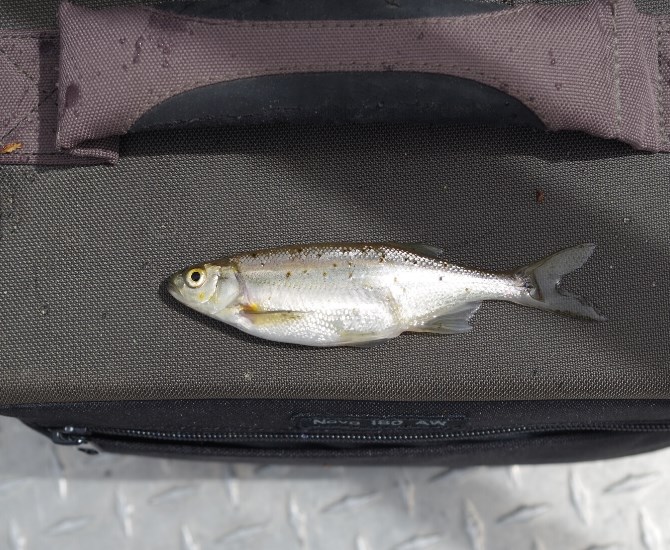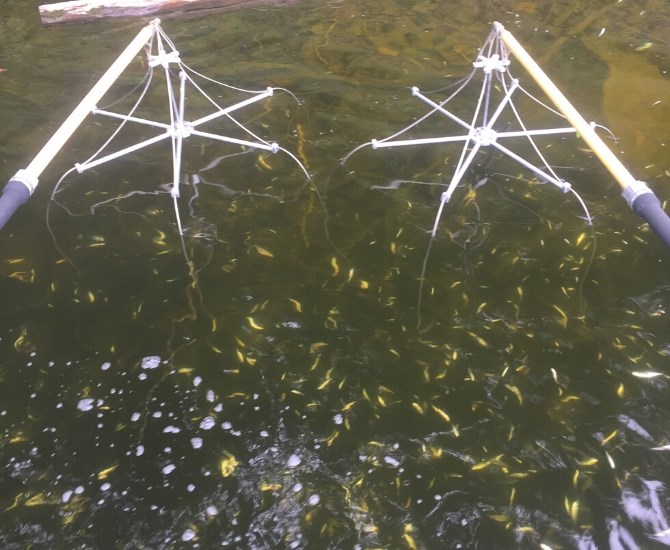
A redside shiner, an invasive fish in Paul Lake, Kamloops.
Image Credit: SUBMITTED / Gene Tisdale
June 13, 2020 - 6:00 PM
An operation to remove invasive fish from a Kamloops lake has yielded promising results.
While electrofishing is still a relatively new tool, the project at Paul Lake may serve as a model to remove invasive fish, in this case a species called redside shiners, from other lakes across the province.
"I grew up on Paul Lake, the shiners have always been an issue here," environmental consultant Gene Tisdale said. "The shiners are competing directly with the rainbows, rainbows aren’t getting big enough to feed on the shiners, so they’re competing for both habitat and food."
Electrofishing uses a generator in a boat that sends electric pulses into the water. These pulses can be calibrated to kill certain fish based on their mass.
After using electrofishing for simply collecting fish, Tisdale realized that it could also be used as a tool to rid lakes of invasive species.
Four years ago he approached the province with his proposal for Paul Lake, and was initially met with doubt.
"They figured that the electrofishing probably wouldn’t work to the point where I would knock them back enough," he said. "So, I took out the regional biologist here and showed him what could be done with the shocker. Impressed him obviously."

Gene Tisdale electrofishing on a B.C. lake.
Image Credit: SUBMITTED / Gene Tisdale
Following the biologist's report, the province put some money towards the four-year project. Tisdale Environmental Consulting and the Freshwater Fisheries Society of B.C. contributed resources as well.
It's unclear how the redside shiners were introduced into Paul Lake, but they were first reported in 1945.
In the first year of the electrofishing project, 85 per cent of the shiner population was removed from the lake. The second year around 90 per cent were removed and in the final two years, another 95 per cent.
Tisdale said that they are already seeing the positive effects on the ecosystem.
"With the shiners (mostly) gone now, the rainbows are actually substantially bigger and in much better condition and are starting to feed on the shiners," he said.
"The condition factor of the fish is substantially better than what it was three years ago."
In the early days of the project, Tisdale noticed that the flesh of the rainbow trout was white, instead of the usual red.
“They were missing shrimp from their diet, the keratin in the shrimp is what gives the red colouration to the flesh,” he said.
Because the rainbows were competing with the shiners, there wasn't enough shrimp to go around.
"By year two I was noticing some of the rainbows were actually starting to get red flesh," he said.
Now in the last year of the project, Tisdale has noticed that almost all of the sub-adult rainbows have orange flesh, which is a big improvement.
"There’s a real indication that the shrimp population has come back and they’re feeding on them," he said.

Attachments on the front of the boat conducting electric shocks into the water, called anodes.
Image Credit: SUBMITTED / Gene Tisdale
As electrofishing is a new tool for invasive species control, there's no guarantee it will work in other lakes. However, the results from the pilot project are promising.
Species around Paul Lake that were affected by the shiners are also making a comeback.
"We're seeing a lot more insect life, as a result of that, we're seeing more bats, more swallows, more foreshore nesting birds," he said.
Turtles and frogs have also been appearing in greater numbers.
The Mayfly hatches at Paul Lake were once famous, but hadn't been seen for the past 15 years or so.
"I'm seeing big hatches again, so that's a direct result of removing the shiners," he said.
This year, Tisdale is using electrofishing to try and solve a similar problem with invasive goldfish in Dragon Lake, near Quesnel. The project will run for three years, with the goal of reducing the goldfish population enough for the remaining individuals to be picked off by predators.
To contact a reporter for this story, email Brie Welton or call (250) 819-3723 or email the editor. You can also submit photos, videos or news tips to the newsroom and be entered to win a monthly prize draw.
We welcome your comments and opinions on our stories but play nice. We won't censor or delete comments unless they contain off-topic statements or links, unnecessary vulgarity, false facts, spam or obviously fake profiles. If you have any concerns about what you see in comments, email the editor in the link above.
News from © iNFOnews, 2020